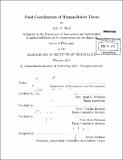Fluid coordination of human-robot teams
Author(s)
Shah, Julie A
DownloadFull printable version (18.55Mb)
Other Contributors
Massachusetts Institute of Technology. Dept. of Aeronautics and Astronautics.
Advisor
Brian Williams.
Terms of use
Metadata
Show full item recordAbstract
I envision a future where collaboration between humans and robots will be indispensable to our work in numerous domains, ranging from surgery to space exploration. The success of these systems will depend in part on the ability of robots to integrate within existing human teams. The goal of this thesis is to develop robot partners that we can work with easily and naturally, inspired by the way we work with other people. My hypothesis is that human-robot team performance improves when a robot teammate emulates the effective coordination behaviors observed in human teams. I design and evaluate Chaski, a robot plan execution system that uses insights from human-human teaming to make human-robot teaming more natural and fluid. Chaski is a task-level executive that enables a robot to robustly anticipate and adapt to other team members. Chaski also emulates a human's response to implicit communications, including verbal and gestural cues, and explicit commands. Development of such an executive is challenging because the robot must be able to make decisions very quickly in response to a human's actions. In the past, the ability of robots to demonstrate these capabilities has been limited by the time-consuming computations required to anticipate a large set of possible futures. These computations result in execution delays that endanger the robot's ability to fulfill its role on the team. I significantly improve the ability of a robot to adapt on-the-fly by generalizing the state-of-the-art in dynamic plan execution to support just-in-time task assignment and scheduling. My methods provide a novel way to represent the robot's plan compactly. This compact representation enables the plan to be incrementally updated very quickly. I empirically demonstrate that, compared to prior work in this area, my methods increase the speed of online computation by one order of magnitude on average. I also show that 89% of moderately-sized benchmark plans are updated within human reaction time using Chaski, compared to 24% for prior art. I evaluate Chaski in human subject experiments in which a person works with a mobile and dexterous robot to collaboratively assemble structures using building blocks. I measure team performances outcomes for robots controlled by Chaski compared to robots that are verbally commanded, step-by-step by the human teammate. I show that Chaski reduces the human's idle time by 85%, a statistically significant difference. This result supports the hypothesis that human-robot team performance is improved when a robot emulates the effective coordination behaviors observed in human teams.
Description
Thesis (Ph. D.)--Massachusetts Institute of Technology, Dept. of Aeronautics and Astronautics, 2011. Cataloged from PDF version of thesis. Includes bibliographical references (p. 235-239).
Date issued
2011Department
Massachusetts Institute of Technology. Department of Aeronautics and AstronauticsPublisher
Massachusetts Institute of Technology
Keywords
Aeronautics and Astronautics.